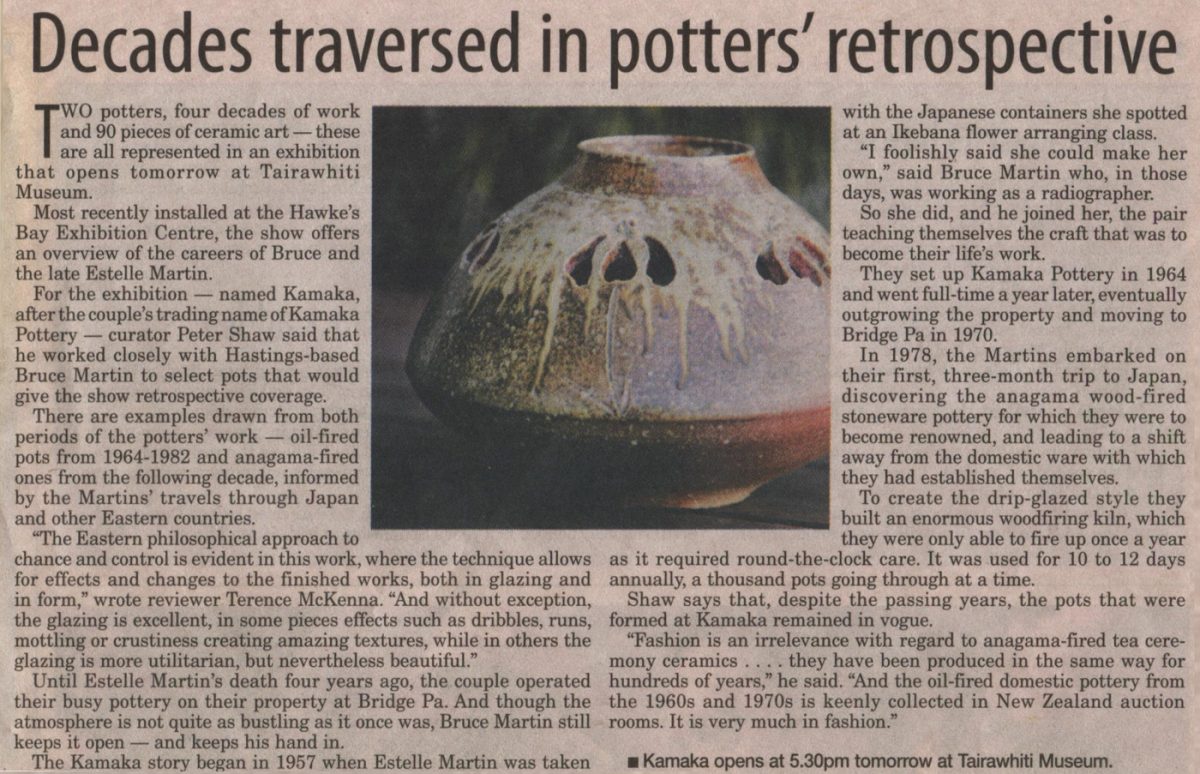Decades traversed in potters’ retrospective
TWO potters, four decades of work and 90 pieces of ceramic art- these are all represented in an exhibition that opens tomorrow at Tairawhiti Museum.
Most recently installed at the Hawke’s Bay Exhibition Centre, the show offers an overview of the careers of Bruce and the late Estelle Martin.
For the exhibition – named Kamaka, after the couple’s trading name of Kamaka Pottery – curator Peter Shaw said that he worked closely with Hastings-based Bruce Martin to select pots that would give the show retrospective coverage.
There are examples drawn from both periods of the potters’ work – oil-fired pots from 1964-1982 and anagama-fired ones from the following decade, informed by the Martins’ travels through Japan and other Eastern countries.
“The Eastern philosophical approach to chance and control is evident in this work, where the technique allows for effects and changes to the finished works, both in glazing and in form,” wrote reviewer Terence McKenna. “And without exception, the glazing is excellent, in some pieces effects such as dribbles, runs, mottling or crustiness creating amazing textures, while in others the glazing is more utilitarian, but nevertheless beautiful.”
Until Estelle Martin’s death four years ago, the couple operated their busy pottery on their property at Bridge Pa. And though the atmosphere is not quite as bustling as it once was, Bruce Martin still keeps it open – and keeps his hand in.
The Kamaka story began in 1957 when Estelle Martin was taken with the Japanese containers she spotted at an Ikebana flower arranging class.
“I foolishly said she could make her own,” said Bruce Martin who, in those days, was working as a radiographer.
So she did, and he joined her, the pair teaching themselves the craft that was to become their life’s work.
They set up Kamaka Pottery in 1964 and went full-time a year later, eventually outgrowing the property and moving to Bridge Pa in 1970.
In 1978, the Martins embarked on their first, three-month trip to Japan, discovering the anagama wood-fired stoneware pottery for which they were to become renowned, and leading to a shift away from the domestic ware with which they had established themselves.
To create the drip-glazed style they built an enormous woodfiring kiln, which they were only able to fire up once a year as it required round-the-clock care. It was used for 10 to 12 days annually, a thousand pots going through at a time.
Shaw says that, despite the passing years, the pots that were formed at Kamaka remained in vogue. “Fashion is an irrelevance with regard to anagama-fired tea ceremony ceramics… they have been produced in the same way for hundreds of years,” he said. “And the oil-fired domestic pottery from the 1960s and 1970s is keenly collected in New Zealand auction rooms. It is very much in fashion.”
Kamaka opens at 5.30pm tomorrow at Tairawhiti Museum.












Do you know something about this record?
Please note we cannot verify the accuracy of any information posted by the community.